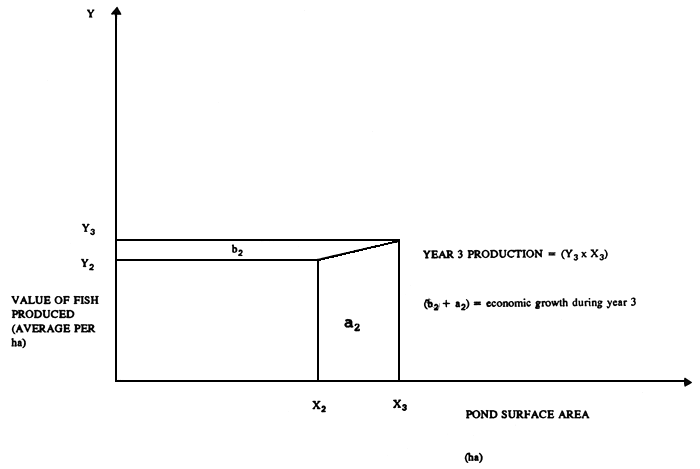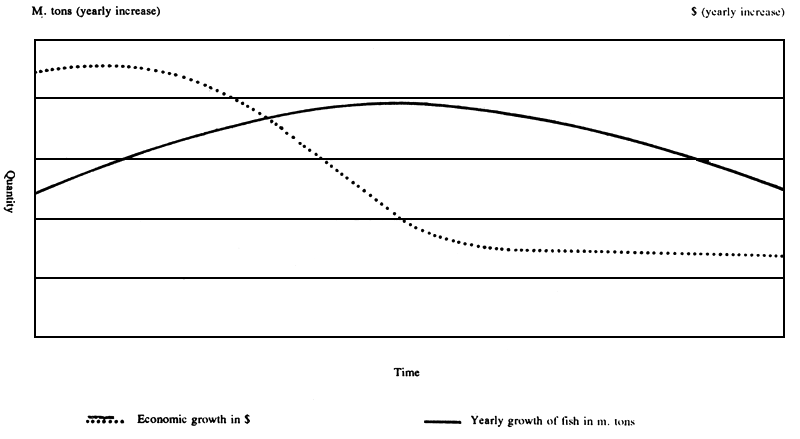For a country, any country, economic growth occurs when the value of goods and services increases from one year to the next. The increase can come about as follows: (i) an activity is started using previously idle resources; (ii) an activity is started using previously used resources and, (iii) an ongoing activity yields more per person employed. In all three cases an increase in the real value8 of goods and services is obtained from one year to the next.
In the first instance the entire value of the production will represent economic growth. In the second, the value of the production must be reduced by the value of the production previously achieved with the same inputs (that is by the value of production actually foregone). In the third case economic growth is represented by the difference in the value of production of the particular enterprises between successive years.
The effects in terms of economic growth that occur when fish culture spreads in an area where the economy has stagnated, underemployment is severe and land and water is ample, is illustrated in Figure 1..
Basic components of economic growth


In both charts the area “b” represents the increase achieved by increased productivity in ponds which were in use at the start of the year. The area “a” represents the increase obtained by culture in ponds constructed during the year. Both “a” and “b” represent economic growth (that is the difference in production achieved from one year to the next). The lower figure, which represents “year 3” then takes as its starting point the production recorded in the top chart for year 2.
In an area with close to fully used land and water (although underemployment prevails) it is somewhat more difficult to introduce fish culture and/or to improve productivity in existing ponds. A new pond will make a smaller net contribution to economic growth, as the price of land and water implies that they could have contributed to production in some alternative employment. It is more difficult to improve productivity as it already should be at least high enough to compensate for the cost of using water and land.
In the long run economic growth from fish culture is going to depend largely on the degree to which the entire agricultural economy takes off. Given the relative unimportance of fish culture in most areas, the introduction of this activity is not by itself going to generate enough wealth to lift the whole rural economy.
Where no growth in the agricultural economy occurs the contribution of fish culture to the national economy may be similar to that in Figure 2.
As time goes by there will be fewer and fewer suitable sites available, and after some years the additions are going to be balanced by ponds going out of production (generally due to bad maintenance or lack of fingerlings).
In the case of an expanding rural economy, with increasing employment possibilities, the contribution of fish culture to the national economy may be like that in Figure 3.
Increase in production of pond-grown fish in a stagnant economy

Increase in production of pond-grown fish in a growing economy

However, as the economy grows, it will become less and less interesting to try to induce additional individuals into the activity and more and more important to improve the performance of those who remain.
The reason that it is becoming, from the national perspective, less and less interesting to entice new entrants into the industry is that their net contribution to economic growth is going to decrease. See Figure 4.
The fish farmers who remain, in what is becoming a specialized field, will find it harder and harder to switch to other activities, and any increase in their productivity can be safely assumed to be a net increase as long as they do not hinder or obstruct other economic activity.
In fact, a cost-price squeeze, causing improved productivity, is likely to force the average farmer to have larger and larger units; and/or to make their existing ponds increasingly productive. This will be a function of the degree to which land and water get scarce in the area.
Thus, more and more, the increase in economic growth is going to equal the increase in productivity (per individual employed). This is illustrated in Figure 5.
The most striking consequence of the above is that even from the cold perspective of national economic growth, a kg of tilapia produced by a poor farmer without alternative income possibilities is worth more than the same kilo in the hands of a well-off farmer located in a region with a growing agricultural economy.
The consequence is of course that as long as there are poor farmers who have time, land and water needed to grow fish in ponds, they should be encouraged to dig the ponds.
When those possibilities have been exhausted, the major source of economic growth from fish farming will come from increased productivity achieved by existing farmers. These people should then become the focus of the extension effort.
Fish produced in new ponds built by “old” farmers and by this year's newcomers, in a growing economy

Economic growth resulting from expansion of fish farming, in a growing economy

Note: one curve shows metric tons of fish, the other its contribution to economic growth in value terms
8. The value change is cleared from the influence of inflation